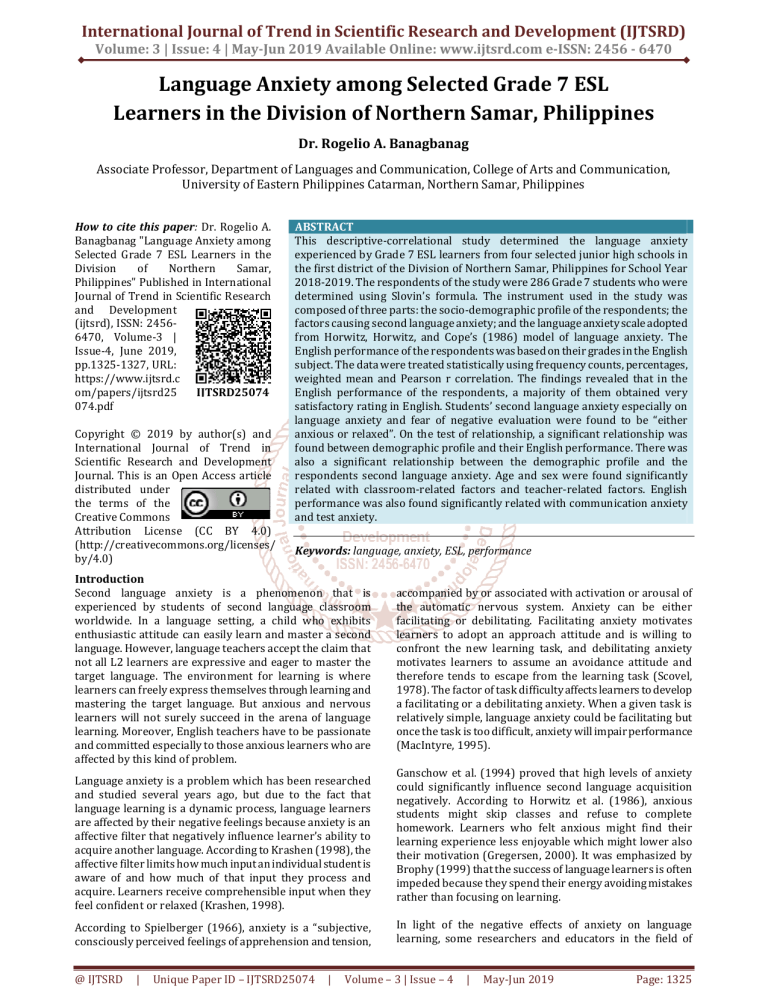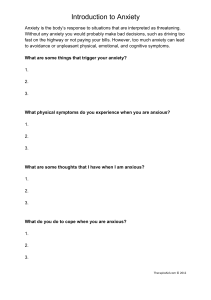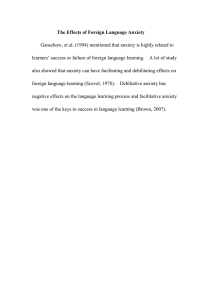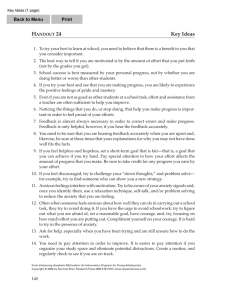
International Journal of Trend in Scientific Research and Development (IJTSRD)
Volume: 3 | Issue: 4 | May-Jun 2019 Available Online: www.ijtsrd.com e-ISSN: 2456 - 6470
Language Anxiety among Selected Grade 7 ESL
Learners in the Division of Northern Samar, Philippines
Dr. Rogelio A. Banagbanag
Associate Professor, Department of Languages and Communication, College of Arts and Communication,
University of Eastern Philippines Catarman, Northern Samar, Philippines
How to cite this paper: Dr. Rogelio A.
Banagbanag "Language Anxiety among
Selected Grade 7 ESL Learners in the
Division
of
Northern
Samar,
Philippines" Published in International
Journal of Trend in Scientific Research
and Development
(ijtsrd), ISSN: 24566470, Volume-3 |
Issue-4, June 2019,
pp.1325-1327, URL:
https://www.ijtsrd.c
om/papers/ijtsrd25
IJTSRD25074
074.pdf
Copyright © 2019 by author(s) and
International Journal of Trend in
Scientific Research and Development
Journal. This is an Open Access article
distributed under
the terms of the
Creative Commons
Attribution License (CC BY 4.0)
(http://creativecommons.org/licenses/
by/4.0)
ABSTRACT
This descriptive-correlational study determined the language anxiety
experienced by Grade 7 ESL learners from four selected junior high schools in
the first district of the Division of Northern Samar, Philippines for School Year
2018-2019. The respondents of the study were 286 Grade 7 students who were
determined using Slovin’s formula. The instrument used in the study was
composed of three parts: the socio-demographic profile of the respondents; the
factors causing second language anxiety; and the language anxiety scale adopted
from Horwitz, Horwitz, and Cope’s (1986) model of language anxiety. The
English performance of the respondents was based on their grades in the English
subject. The data were treated statistically using frequency counts, percentages,
weighted mean and Pearson r correlation. The findings revealed that in the
English performance of the respondents, a majority of them obtained very
satisfactory rating in English. Students’ second language anxiety especially on
language anxiety and fear of negative evaluation were found to be “either
anxious or relaxed”. On the test of relationship, a significant relationship was
found between demographic profile and their English performance. There was
also a significant relationship between the demographic profile and the
respondents second language anxiety. Age and sex were found significantly
related with classroom-related factors and teacher-related factors. English
performance was also found significantly related with communication anxiety
and test anxiety.
Keywords: language, anxiety, ESL, performance
Introduction
Second language anxiety is a phenomenon that is
experienced by students of second language classroom
worldwide. In a language setting, a child who exhibits
enthusiastic attitude can easily learn and master a second
language. However, language teachers accept the claim that
not all L2 learners are expressive and eager to master the
target language. The environment for learning is where
learners can freely express themselves through learning and
mastering the target language. But anxious and nervous
learners will not surely succeed in the arena of language
learning. Moreover, English teachers have to be passionate
and committed especially to those anxious learners who are
affected by this kind of problem.
Language anxiety is a problem which has been researched
and studied several years ago, but due to the fact that
language learning is a dynamic process, language learners
are affected by their negative feelings because anxiety is an
affective filter that negatively influence learner’s ability to
acquire another language. According to Krashen (1998), the
affective filter limits how much input an individual student is
aware of and how much of that input they process and
acquire. Learners receive comprehensible input when they
feel confident or relaxed (Krashen, 1998).
According to Spielberger (1966), anxiety is a “subjective,
consciously perceived feelings of apprehension and tension,
@ IJTSRD
|
Unique Paper ID – IJTSRD25074
|
accompanied by or associated with activation or arousal of
the automatic nervous system. Anxiety can be either
facilitating or debilitating. Facilitating anxiety motivates
learners to adopt an approach attitude and is willing to
confront the new learning task, and debilitating anxiety
motivates learners to assume an avoidance attitude and
therefore tends to escape from the learning task (Scovel,
1978). The factor of task difficulty affects learners to develop
a facilitating or a debilitating anxiety. When a given task is
relatively simple, language anxiety could be facilitating but
once the task is too difficult, anxiety will impair performance
(MacIntyre, 1995).
Ganschow et al. (1994) proved that high levels of anxiety
could significantly influence second language acquisition
negatively. According to Horwitz et al. (1986), anxious
students might skip classes and refuse to complete
homework. Learners who felt anxious might find their
learning experience less enjoyable which might lower also
their motivation (Gregersen, 2000). It was emphasized by
Brophy (1999) that the success of language learners is often
impeded because they spend their energy avoiding mistakes
rather than focusing on learning.
In light of the negative effects of anxiety on language
learning, some researchers and educators in the field of
Volume – 3 | Issue – 4
|
May-Jun 2019
Page: 1325
International Journal of Trend in Scientific Research and Development (IJTSRD) @ www.ijtsrd.com eISSN: 2456-6470
second language learning have been trying to identify the
sources of second language anxiety so as to help learners
reduce anxiety in learning a second language. Some of the
sources of second language anxiety are associated with the
learner, some with the teacher, and some with the
instructional practice.
This study focused on the anxiety experienced by the Grade
7 ESL learners of selected junior high schools in the first
district of the Division of Northern Samar. Specifically, this
study attempted to: determine the socio-demographic
profile of the respondents; determine the performance of the
respondents in their English subject; determine the factors
causing second language anxiety; determine the second
language anxiety experienced by the respondents; find out
significant relationships between the profile and English
performance, profile and second language anxiety, profile
and the factors causing language anxiety, and English
performance and language anxiety.
METHODOLOGY
This study used the descriptive-correlational design focusing
on determining the second language anxiety of ESL learners
in the Division of Northern Samar, Philippines. The
respondents of the study were 286 Grade 7 students
representing four selected public secondary schools in the
division for School Year 2018-2019. The number of
respondents were determined using Slovin’s formula. The
instrument used in the study was composed of three (3)
parts. The first part is on the socio-demographic profile of
the respondents, the second part is on the factors causing
second language anxiety, the third part is the language
anxiety scale adopted from Horwitz, Horwitz, and Cope’s
(1986) model of language anxiety. The English performance
of the respondents was based on their grades in the English
subject. The data were treated statistically using frequency
counts, percentages, weighted mean and Pearson r
correlation.
RESULTS AND DISCUSSION
Profile of the Respondents
Regarding the profile of the respondents, a majority of them
or 61.89% were 12-13 years old and considered to be an
appropriate age to attend the 7th Grade. From the 286
respondents, 143 of them were male and another 143 were
female. Most of them or 47.20% reported to have a monthly
family income lower than Php5,000, while there was only
4.90% who reported to have a family income of
Php20,000.00 above per month. The data also revealed that
a majority of the respondents or 94.06% attended public
elementary schools and only 5.95% attended private
elementary schools.
classroom-related factors, the highest mean is 3.68 or “much
expected” on noisy learning environment as one factor that
triggers language anxiety. For teacher-related factors, the
highest mean is 3.56 or “much expected” on the indicator
“high standard teaching practices” as the most expected to
cause language anxiety. The lowest mean is 3.38 or
“expected” for the teacher who demonstrates annoying
gestures and facial expressions as the factor that causes the
least second language anxiety.
Second Language Anxiety
Second language anxiety is categorized into: communication
anxiety, test anxiety, fear of negative evaluation, and anxiety
of English classes.
As regards communication anxiety, the students were
“anxious” when they are in their English class. It has the
highest mean which is 3.88. Grade 7 students were not quite
sure of themselves while using the language during their
class. They exhibit shyness and they are afraid to speak in
the target language in their class. On the contrary, the
statement which describes that Grade 7 students are not
nervous when they do not understand every word the
English teacher says had the lowest mean of 2.0 and is
interpreted as “moderately relaxed”. In other words, they are
not nervous whenever they do not understand what their
teacher in English is saying. In general, the communication
anxiety of the Grade 7 respondents was “either anxious or
relaxed” with a grand weighted mean of 3.03.
On test anxiety, the Grade 7 students were anxious having a
weighted mean of 3.62. Specifically, students worry so much
about making mistakes in English tests. It has a weighted
mean of 3.80 interpreted as “anxious”. The lowest mean is
3.38 interpreted as “either anxious or relaxed” for the
statement that if they study for a language test, the more that
they get confused.
On the fear of negative evaluation, the respondents were
either anxious or relaxed with a weighted mean of 3.31. The
highest mean is 3.70, that is, students were anxious when
they know that they are going to be called on in an English
class.
With regard to the anxiety of English classes, the
respondents were anxious, with a weighted mean of 3.44.
This means that the students were in the state of panic and
they get nervous setting in an English class. The highest
weighted mean falls on the statement that they get
frightened when they do not understand what the teacher is
saying in the English language. It has a weighted mean of
3.78 interpreted as either anxious or relaxed”.
English Performance
The data on the English performance of the respondents
were taken from their final grade in the English subject.
From the 286 respondents, 9.44% got an average of 90-100
or outstanding, 18.88% with 85-89 or very satisfactory,
41.26% with 80-84 final grade or satisfactory, 30.42% with
75-79 grade or fairly satisfactory. Nobody got a grade below
75.
Generally, the Grade 7 students were “either anxious or
relaxed” of the second language with a grand mean of 3.34. It
tells that the Grade 7 students agree and disagree with some
of the statements indicated in the second language anxiety
scale. It shows that they are anxious particularly when the
atmosphere of the classroom is threatening. However, they
are relaxed and confident when supportive learning
environment is fostered.
Factors Causing Second Language Anxiety
Factors causing second language anxiety are categorized into
classroom-related and teacher-related factors. Based on the
computation of the weighted mean for each indicator for
Tests of Relationships
On the relationship between the demographic profile of the
respondents and their English performance, the study
revealed that age and sex were significantly related to
@ IJTSRD
|
Unique Paper ID – IJTSRD25074
|
Volume – 3 | Issue – 4
|
May-Jun 2019
Page: 1326
International Journal of Trend in Scientific Research and Development (IJTSRD) @ www.ijtsrd.com eISSN: 2456-6470
English performance. On the relationship between the
profile and their second language anxiety, age was found to
be significantly related to fear of negative evaluation. Sex
was significantly related to communication anxiety and
anxiety of English classes.
Age, sex, English performance and last school attended were
significantly correlated to classroom-related factors of
anxiety. Meanwhile, sex was significantly correlated with
teacher-related factors.
It was also found out that English performance was
significantly related to communication anxiety and test
anxiety.
The results of the survey clearly reveal that most anxietyprovoking areas were test anxiety and anxiety of English
classes. It was acknowledged in this study that most of the
respondents feel anxious and nervous while speaking
English in front of others. Some respondents agreed that
they feel anxious when they cannot speak English well.
CONCLUSIONS
Based on the findings of the study, the following conclusion
were drawn:
The language anxiety of Grade 7 ESL learners of the selected
schools in the Division of Northern Samar, Philippines is
significantly related to their demographic profile, final grade
in English subject, and factors causing second language
anxiety.
English performance of ESL learners is related to classroom
factors because when students have poor English
performance that means they are poorly engaged in their
English class. The mean reason is due to environmental
factors such as disorganized management, exposure to
different kinds of noise, and unfavorable atmosphere due to
hot classroom temperature and poor facilities.
English performance of the learner is negatively affected by
the anxiety experienced of the learner in communicative
situations. One of the reasons why a learner fail in the
English subject is because of the test anxiety that they
experience. They will not be able to attain outstanding
@ IJTSRD
|
Unique Paper ID – IJTSRD25074
|
performance in the subject because they showed fear of
failing in language tests.
Acknowledgment
This study was made possible through the cooperation of the
principals of the schools subjected to this study, the teachers
and the Grade 7 students.
References
[1] Brophy, J. (1999). Working with perfectionist students.
(Report No. 4). Urbana, IL: ERIC Clearinghouse on
Elementary and Early Childhood Education. (ERIC
Document Reproduction Service No. ED 400124).
[2] Ganschow, L., Sparks, R. L. Anderson, R., Javorshy, J.
Skinner, S., and Jon, P. (1994). Differences in language
performance among high-, average-, and low-anxious
college foreign language learners. The Modern
Language Journal. http://dx.doi.org/10.2307/329251.
[3] Gregersen, T. G. (2000). Improving teaching
methodologies for communicatively apprehensive
foreign language students. Lenguas Modernas. 26-27,
119-133.
[4] Horwitz, E. K., Horwitz, M. B., and Cope, J. A. (1986).
Foreign language classroom anxiety. The Modern
Language
Journal.
70(2),
125-132.
http://dx.doi.org/10.2307/327317.
[5] Krashen, S. (1998). Comprehensible output system.
26(2),
175-182.
http://www.sdkrashen.com/content/articles/compreh
ensible_output.pdf.
[6] MacIntyre, P. D. (1995). How does anxiety affect second
language learning? A reply to Sparts and Ganschow.
Modern Language Journal. 79(1), 90-99.
[7] Scovel, T. (1978). The effects of foreign language
learning. A review of anxiety research. Language
learning. 28(1), 129-42.
[8] Spielberger, C. D. (1966). Theory and research on
anxiety. In C. D. Spielberger (ed.). Anxiety and behavior.
New York: Academic Press. 3-20.
Volume – 3 | Issue – 4
|
May-Jun 2019
Page: 1327



